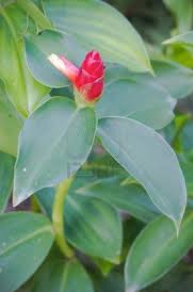Setawar Halia Merah
| Setawar Halia Merah | |
| Scientific name | Costus speciosus (Koenig) sm |
| Synonyms | Cheilocostus specious, Costus woodsonii |
| Common name | spiral ginger or Crepe gingeror Red Button Ginger |
| Family | Costaceae |
| Order | Zingiberales |
| Plant material of Interest | Grown as medicinal and ornamental plants. The rhizome is the major source of diosgenin-anti diabetic |
 |
{slider=Geographical & Distribution}
Native to the Peninsular of Malaysia. Distributed throughout India.
{/slider}
{slider=General Appearance}
Perennial rhizomatous herb with erect or spreading stems The leaves are large and spirally arranged on stems. The leaves are sub sessile and appear dark green in colour, elliptic or obovate in shape. The inflorescence is a spike around 10 cm long with large bracts in sub terminal position. Bracts are ovate or mucronate and bright red colour. Flowers are white in colour, 5-6 cm long with a cup-shaped labellum and crest yellow stamens. Fruits is capsule and red in clour. Seeds are black, five in number with white fleshy aril
{/slider}
{slider=Cultivation}
Grown in fertile, organic, moist, well-deained soils in shade. Tropical climate with high humidity and minimum temperature 13°C is best for its cultivation. Grows or reproduces vegatatively: from rhizome, division of culms, stem cutting.
{/slider}
{slider=Chemical Content}
Rhizome: steroid sapogenin, diosgenin.
Sterol, Flavanoid, Steroid, Anthraquinones, essential oil, coumarin & carboxlic acid, cardiac glycosides, saponin, alkaloid.
Rhizome: Tigogenin and diosgenin, curcumin and curcuminoids Tetradecyl 13-methylpentadecanoate, tetradecyl 11-methyltridecanoate, 14-oxotricosanoic acid, 14-oxoheptacosanoic acid & 15-oxooctacosanoic acid. Methyl 3-(4-hydroxyphenyl)-2E propenoate. Susquiterpene: Costunolide and eremanthin
Seed : hypotensive and spasmolytic effect. Saponin. Seed oil: 6 % consists of palmitic acid (55.97%), oleic acid (23.75%), linoleic, stearic, myristic and lauric acids. Defatted seeds contained diosgenin, glucose, galactose amd rhamnose. Seed: quinonesdihydrophytylplastoquinone & 6-methyl derivatives and α- tocopherol.
Roots: 31-norcycloartanone, cycloartanol, cycloartenol and cyclolaudenol . 5 α-stigmasten-3b-ol, sitosterol-B-D-glucoside, dioscin, prosapogenins A & B of dioscin, gracillin and quinines, saponin.
Sterol - 5α-stigmast-9(11)-en-3β-ol (Gupta M.M et al, 1981).
Rhizome: Tigogenin and diosgenin, curcumin and curcuminoids Tetradecyl 13-methylpentadecanoate, tetradecyl 11-methyltridecanoate, 14-oxotricosanoic acid, 14-oxoheptacosanoic acid & 15-oxooctacosanoic acid. Methyl 3-(4-hydroxyphenyl)-2E propenoate. Susquiterpene: Costunolide and eremanthin
Leaves: α-amyrinsterate, β-amyrin and lupeolPalmitates was isolated from leaves.
{/slider}
{slider=Traditional Uses}
Rhizome: treatment of abdominal pain, liver problems, juandice, gall bladder pain.
Leucorrhoea, clearing of urine.
Stimulant, carminative, diuretic, digestive and antiseptic properties.
Rhizome: Bitter and antihelmintic, astringent, expectorant properties.
The rhizome extract is used as tonic and useful in relieving burning sensation, constipation, leprosy, asthma, bronchitis, anaemia and other skin ailments. Remedy for fever. Hepatoprotective. Rhizome paste is used for treating boils and also to make sexual hormones and contraceptives.
Rhizome also used for treating snake bites.
Cardiotonic, hydrochloetic, diuretic and CNS despressant activity
Antifertility, anticholineterase, anti-infalmmatory, antipyretic and antihelminthic
Leaves: scabies and stomach ailments.
Stems: Stems are ground into paste and applied for blisters.
Traditional Uses:
To treat high blood pressure and bladder disorder.:decoction of the whole plant in water and drink.
To treat ear infection: Roast the small plant, then squeeze to extract a few drop of sap and put on the affected area.
{/slider}
{slider=Pharmacology}
Antioxidant: The treatment of the STZ-induced diabetic with costunolide and remanthin isolated from C. speciosus alleviated the oxidative stress conditions, indicating the protective nature of these compounds (Elitza et al 2010)
Fresh juice of the rhizomes of C. specious increased the tone, amplitude and frequency of rhythmic contractions of isolated uterus of rat, guinea-pig, rabbit, dog and human. The spasmodic activity was not blocked by atropine sulphate and pentolinium bitartrate. It use as ecbolic in the indigenous systems of medicine Tewari et al. The chloroform extract of dried powdered rhizomes, after being extracted with petroleum ether and benzene, possesed the most potent and direct stimulant action on isolated uterus. The extract was found to contain a mixture of 5 saponins of varying proportions as revealed by thin-layer chromatography (TLC). (B. Dasgupta & V.B. Pandey, 1969)
Antimicrobial: Aqueous extract of rhizome have antibacterial activity against Staphylococcus aureus.
Rhizome: bitter and antihelmintic, astringent, expectorant properties. The rhizome extract is used as tonic and useful in relieving burning sensation, constipation, leprosy, asthma, bronchitis, anaemia and other skin ailments. Remedy for fever. Hepatoprotective. Rhizome paste is used for treating boils and also to make sexual hormones and contraceptives.
Rhizome: treating snake bites.
Cardiotonic, hydrochloetic, diuretic and CNS despressant activity
Antifertility, anticholineterase, anti-inflammatory, antipyretic and antihelminthic
Leaves: scabies and stomach ailments.
Stems: Stems are ground into paste and applied for blisters.
{/slider}
{slider=Toxicity}
Acute toxicity test showed that there was no mared changes in feed intake. Behavioural changes like irritation, restlessness, respiratory distress, abnormal locomotion and catalapsy over a period of 10 days were not observed (Elitza J. et al., 2010)
{/slider}
{slider=Reference}
Aparna Saraf (2010) Phytochemical and Antimicrobial Studies of Medicinal Plant Costus Speciosus (Koen.) E-Jounal of Chemistry Vol 7 (2010), S1 Pages SS405-S413 http://www.hindawi.com/journals/chem/2010/605735/abs/
Md. Shahadat Hossan, Abu Hanif, Bipasha Agarwala, Md. Shahnawaz Sarwar, Masud Karim, Rownak Jahan, Mohammed Rahmatullah, Traditional Use of Medical Plants in Bangladesh to treat Urinary Tract Infections and Sexually Transmiteed www.ethnobotanyjournal.org/vol8/i1547-3465-08-061.pdf
B. Dasgupta & V.B. Pandey 1969) A New Indian Source of Diosgenin (Costus speciosus) http://download.springer.com/static/pdf/813/art%253A10.1007%252FBF01898450.pdf?auth66=1381541810_6dbd24ffca1f4348959150caf50cdb4e&ext=.pdf
Rani A.S. G. Sulakshana & S. Patnaik (2012). Costus speciosus, An antidiabetic Plant –Review. FS J Pharm Res Vol 1(3) 52-53http://www.researchgate.net/publication/ 233910986.
Elitza J. P. Daisy and S. Ignacimuthu, (2010). Antioxidant activity of costunolide and eremanthin isolated from Costus speciosus (Koen ex. Retz) Sm.Chemico-Biological Interactions 188 467-472.
{/slider}
- Last updated on .
- Hits: 9936
